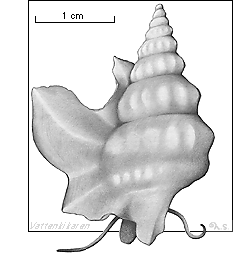|

Distribution in scandinavian waters
|
Maximum length: 4,5 cm.
Appearance: Adults have a swim foot like outer lip. The shell
has a distinct spire and has a cream yellow - white colour with a brown
yellow shade. The whitish creature has a reddish trunk. The eyes are
placed at the base of the tentacles. The
foot, shell opening and lid have an oval form.
Depth: 4-180 m. The Pelican's foot shell normally lives to deep
to able to see living examples on the beach, but empty shells,
washed up onto the beach can be found.
Environment: Lives dug
down in soft bottoms.
Misc: It is believed that mating takes place primarily during
the spring. The eggs are placed either individually or in groups of
two or three on grains of sand or other particles. After a few weeks,
the egg hatches and the larva swims out of the shell. It is believed
that the larvae
drift with the currents
under a notable period of time.
The outer lip of the shell acts as a protective
covering for the
head.
Classification: There is one relation of the Pelican
foot shell that is found, although quite rare, in Swedish
waters. It is found on deep muddy bottoms in Bohuslän
on the Swedish west coast. It is recognized by its thin
shell, and the more sharper and denser whorls. The raised
outer lip of adults has conspicuous points.
The Pelican´s foot shell belongs to the subclass
Prosobranchia (sea-snails) under the class Gastropoda (snails and slugs),
which is part of the molluscs.
|


